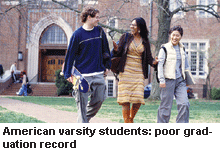The world is entering an era of “mass access” to higher education, with “immense” implications for societies and university systems. The era’s advent was heralded by Philip Altbach, director of the Centre for International Higher Education at Boston College in the US, in the wake of a report published in September by the Organisation for Economic Co-operation and Development (OECD). The analysis, Education at a Glance, says that the number of people with degrees or equivalent qualifications in member nations rose by 4.5 percent every year since 1998, a phenomenon led by “massive” public investment in universities. In some nations, including Spain and Turkey, the figure was 7 percent a year or more.
 Across all OECD countries, one in three people aged between 25 and 34 now has a tertiary level qualification, the annual report says. In Canada, Japan and South Korea, the figure is one in two. In an interview with Times Higher Education, Professor Altbach said the world is moving towards a mass-access model, with many countries, including most in the OECD, achieving access of more than 30 percent. The implications, he says, are huge, and pose major political questions, including the crucial issue of who should pay for higher education. “More money is being spent on post-secondary education, and increasingly the funds are coming from students and their families because societies are unable, or unwilling, to pay for increased access,” says Altbach.
Across all OECD countries, one in three people aged between 25 and 34 now has a tertiary level qualification, the annual report says. In Canada, Japan and South Korea, the figure is one in two. In an interview with Times Higher Education, Professor Altbach said the world is moving towards a mass-access model, with many countries, including most in the OECD, achieving access of more than 30 percent. The implications, he says, are huge, and pose major political questions, including the crucial issue of who should pay for higher education. “More money is being spent on post-secondary education, and increasingly the funds are coming from students and their families because societies are unable, or unwilling, to pay for increased access,” says Altbach.
He believes this has led to unprecedented growth in private provision and the privatisation of public higher education, and has driven a global trend towards higher tuition fees. “Only a few OECD nations, especially in northern Europe, still resist significant tuition fees,” says Altbach. He predicts that the era of mass access would put the greatest pressure on less prestigious institutions, which are absorbing students from families who have not previously sent their children to university.
But he adds that elite universities catering for the upper-middle classes would also face challenges, not least greater competition from mass-access institutions for state funding and support. The OECD report shows significant variations in access between nations and major shifts over time. On average, across countries, university-level graduate rates doubled from 18 percent in 1995 to 36 percent in 2007. “As the pace of change has differed widely... the relative standing of countries on this measure has changed dramatically since 1995,” the report says. Finland, for example, moved from tenth in 1995 to third in 2007, whereas the US dropped from second to 14th over the same period.
Comments Altbach: “The reason that the US has fallen behind is that it continues to do an excellent job of access to higher education, but a poor job of ensuring that students complete their degrees. Indeed, this is the hidden crisis of American higher education.”
The report also illustrates higher education’s impressive returns to individuals and nations. Across member countries, it states that a male student, for example, who completes a university degree can look forward to a lifetime gross earnings premium of more than $186,000 (Rs.85 lakh) on average, compared with someone who completes only secondary education. The net public return from investment in tertiary education can be almost twice the amount of public investment.
(Excerpted and adapted from Times Higher Education)